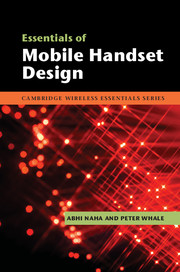5 - Software design
Published online by Cambridge University Press: 05 October 2012
Summary
In this chapter, we examine the major software components of a mobile handset and the key design issues which affect their design. The Motorola DynaTAC, the world's first portable cellular handset, first announced in 1973, required minimal software, and utilized a simple microcomputer built with fewer than 2000 transistors. A modern smartphone, such as the iPhone 4GS, supports 16 Gbyte of flash and 256 Mbyte of RAM, and could have a billion transistors to perform all of the functions of the device. Given the range of software complexity over time, and the range of device types from a basic ultra-low-cost handset to a high-end tablet, we shall focus on core software elements which exist in various forms in all modern handsets, from ultra-low-cost handsets through to smartphones, and we shall define a model of software structure and its evolution which can be matched to these different device types. This approach permits us then to draw out the key design issues and how these have changed – or not – over time.
For explanatory purposes, we shall divide handset software into three broad groups, each of which has its own distinctive design issues:
application software design – software related to the provision of applications and services to the user of the device, including underlying OS capabilities where applicable;
protocol stack software design – software related to the exchange of messaging between the handset and the network in order to provide a set of mobile communication capabilities;
physical layer software design – software related to the encoding and decoding of data via the air interface, and the control of associated hardware.
After examining each of these software areas and associated design issues, we shall conclude with a review of a set of broader design issues related to mobile operating systems, used in smartphones, and mobile execution environments, used in feature phones.
- Type
- Chapter
- Information
- Essentials of Mobile Handset Design , pp. 130 - 161Publisher: Cambridge University PressPrint publication year: 2012



